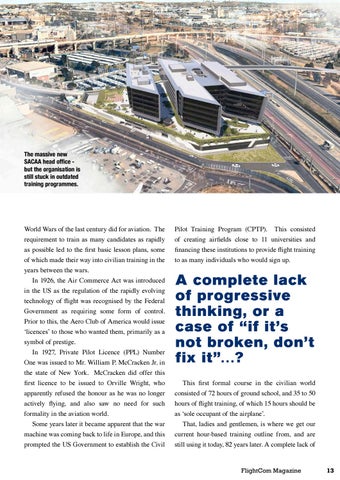The massive new SACAA head office but the organisation is still stuck in outdated training programmes.
World Wars of the last century did for aviation. The requirement to train as many candidates as rapidly as possible led to the first basic lesson plans, some of which made their way into civilian training in the years between the wars. In 1926, the Air Commerce Act was introduced in the US as the regulation of the rapidly evolving technology of flight was recognised by the Federal Government as requiring some form of control. Prior to this, the Aero Club of America would issue ‘licences’ to those who wanted them, primarily as a symbol of prestige. In 1927, Private Pilot Licence (PPL) Number One was issued to Mr. William P. McCracken Jr. in the state of New York. McCracken did offer this first licence to be issued to Orville Wright, who apparently refused the honour as he was no longer actively flying, and also saw no need for such formality in the aviation world. Some years later it became apparent that the war machine was coming back to life in Europe, and this prompted the US Government to establish the Civil
Pilot Training Program (CPTP). This consisted of creating airfields close to 11 universities and financing these institutions to provide flight training to as many individuals who would sign up.
A complete lack of progressive thinking, or a case of “if it’s not broken, don’t fix it”…? This first formal course in the civilian world consisted of 72 hours of ground school, and 35 to 50 hours of flight training, of which 15 hours should be as ‘sole occupant of the airplane’. That, ladies and gentlemen, is where we get our current hour-based training outline from, and are still using it today, 82 years later. A complete lack of
FlightCom Magazine
13
